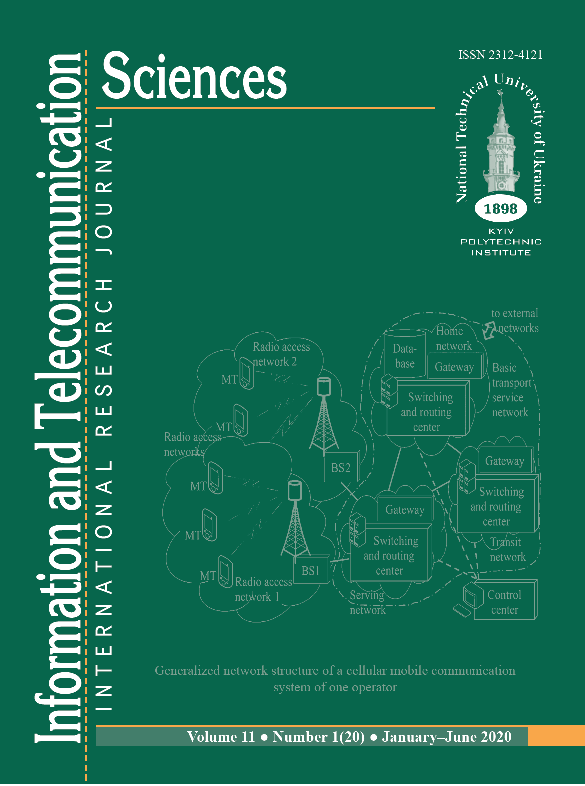FEASIBILITY REASONING OF CREATING ULTRA-LOW ORBIT COMMUNICATION SYSTEMS BASED ON SMALL SATELLITES AND METHOD OF THEIR ORBITS DESIGNING
DOI:
https://doi.org/10.20535/2411-2976.12020.59-70Keywords:
satellite, micro-satellite, nano-satellite, satellite communications, cluster satellite of navigation and communications, orbit arrangement.Abstract
Background. The article is devoted to the substantiation of the approach to solving the global problem for mankind: the creation of satellite communications technology that does not pollute space with debris. Ultra-low-orbit satellite communication systems (ULO SCS) are communication systems with cluster (distributed) satellites that form a grouping (armada) of small, ultra-small, nano-, pico-satellites that move in orbits close to the dense layers of the Earth’s atmosphere (sliding on the upper edge of the dense layer of the Earth’s atmosphere - a sliding orbit). The motion in such orbit of a small-sized apparatus (provided that the engine is not started) leads to its rapid deceleration and complete combustion in the Earth’s atmosphere, i.e. complete orbit purification from space debris.
Objective. To justify the feasibility and the possibility of creating and maintaining the functioning of an economical, nonpolluting space, global satellite communications system built using small (mini-, nano-, pico-) satellites.
Methods. The theoretical approach is proposed that allows constructing the orbits of mini-nano- and picosatellites based on the use of the national design groundwork.
Results. The article developed a method for constructing ultra-low orbit clusters of nano-satellites (small satellites) to increase the efficiency of using aerospace systems when creating and maintaining the life cycle of ULO SCS.
Conclusions. The method of orbits arrangement by distributed satellites is described. The technological capabilities of Ukraine to implement the method using national aerospace systems are quantified. There is scientific, technical and technological groundwork in the field of AS in Ukraine - these are the “flying cosmodromes” of An-124-100 and An-225 airplanes.
References
Starlink, https://www.youtube.com/watch?v=ySCG2Z_ FsYQ/,
last accessed 2019.
Wind-sail, https://wind-sail.ru/equpment/svyaz/sistemamobilnoj-
sputnikovoj-svjazi-iridium/, last accessed 2019.
Vse sputniki svyazi, http://ecoruspace.me/, last accessed 2019.
Satlink, http://www.satlink.ru/Spytnikovaia_sviaz/ Iridium/
Tehnicheskie_ harakteristiki/, last accessed 2019.
Lysenko, O., Yavisya, V., Tureichuk, A., Alekseeva. I.:
Monitoring system and fixed communication on the
basis of nanosatellites. 5th International Scientific-
Practical Conference Problems of Infocommunications.
Science and Technology, pp. 495-498. Kyiv, Ukraine (2018).
Neganov, N., Klyuev, D., Tabakov, D.: Ustroystva
SVCH i antenny. Teoriya i tekhnika antenn. Chast' 2, 728 p. Moscow, Yeditorial (2016).
Hi-news.ru, http://hi-news.ru/science/izobreteny-mikrodvigatelidlya-
nanosputnikov.html/, last accessed 2019.
Yavisya, V., Bendasiuk, N.: Analysis of methods fo
orientation and stabilization of nano-satellites. 4th
International Conference Methods and Systems of
Navigation and Motion Control, pp. 158-161. Kyiv, Ukraine (2016).
B-eco, http://b-eco.ru/solar_panels, last accessed 2019.
Solarb.ru, http://solarb.ru/solnechnye-batarei-vkosmicheskom-
prostranstve/, last accessed 2019.
Astronews, http://www.Astronews.Space/Spacecrafts-
/252-Raschet-Stoimosti-Proizvodstva-Obsluzhivaniya-
I-Zapuska-Raket-Falcon-9-I-Falcon-Heavy-Kompanii-Spacex/, last accessed 2019.
Virgin Orbit, https://uazmi.org/news/post/ghvjbxmN6zT3F7w4QYohsU/, last accessed 2019.
Lysenko, O., Chekanova, І., Gusynin, V, Serdyuk І.,
Zhukov V.: Podkhody k sozdaniyu natsional'noy
aviatsionno-kosmicheskoy sistemy legkogo klassa.
Adaptivnyye sistemy avtomaticheskogo upravleniya,
№4(24), pp. 39-44. Kyiv, Ukraine (2002).
Lysenko, O., Tachinina, О., Alekseeva, І.: Rozvytok
metodu optymizatsiyi roz·haluzhenykh trayektoriy u
zadachakh rozrakhunku opornoho rukhu dvostupenevoho
bezpilotnoho demonstratora hiperzvukovykh
tekhnolohiy, № 1, pp. 101-108. Kyiv, Ukraine (2018).
Lysenko, O., Tachinina, О.: Method of path constructing
of information robot on the basis of unmanned aerial
vehicle. Proсeedings of the National Aviation University,
№ 4(73), pp. 60-68. Kyiv, Ukraine (2017).
Lysenko, O., Tachinina, О., Alekseeva, І.,
Zacharchenko, V.: The optimal injection path of group of
nanosatellite multisensor-based platforms. IEEE 4th
International Conference «Methods and Systems of
Navigation and Motion Control», pp. 155-158. Kyiv, Ukraine (2016).
Lysenko, O., Tachinina, О., Alekseeva, І. :Path
Constructing Method of Unmanned Aerial Vehicle.
IEEE 4th International Conference, «Actual Problems of
Unmanned Aerial Vehicles Developments», pp. 254-259. Kyiv, Ukraine (2017).
Lysenko, O., Tachinina, О., Alekseeva, І.: Algorithm for
operational optimizationof two-stage hypersonic
unmanned aerial vehicle branching path. IEEE 5th
International Conference «Methods and Systems of
Navigation and Motion Control», pp. 11-15. Kyiv, Ukraine (2018).
Sparavalo, M. Adequate mathematical modelling by
wide-sense robust control design in a thrust-vectored
flight dynamics problem. CEAS Aeronaut J 11, 289–301
(2020). https://doi.org/10.1007/s13272-019-00425-x
Sparavalo, M. Lyapunov Functions in Nonlinear
Unsteady Dynamics and Control: Poincaré’s Approach
from Metaphysical Theory to Down-to-Earth Practice. –
Ed.1. – LaVergne: Lightning Source Inc., 2016. – 104 p.

